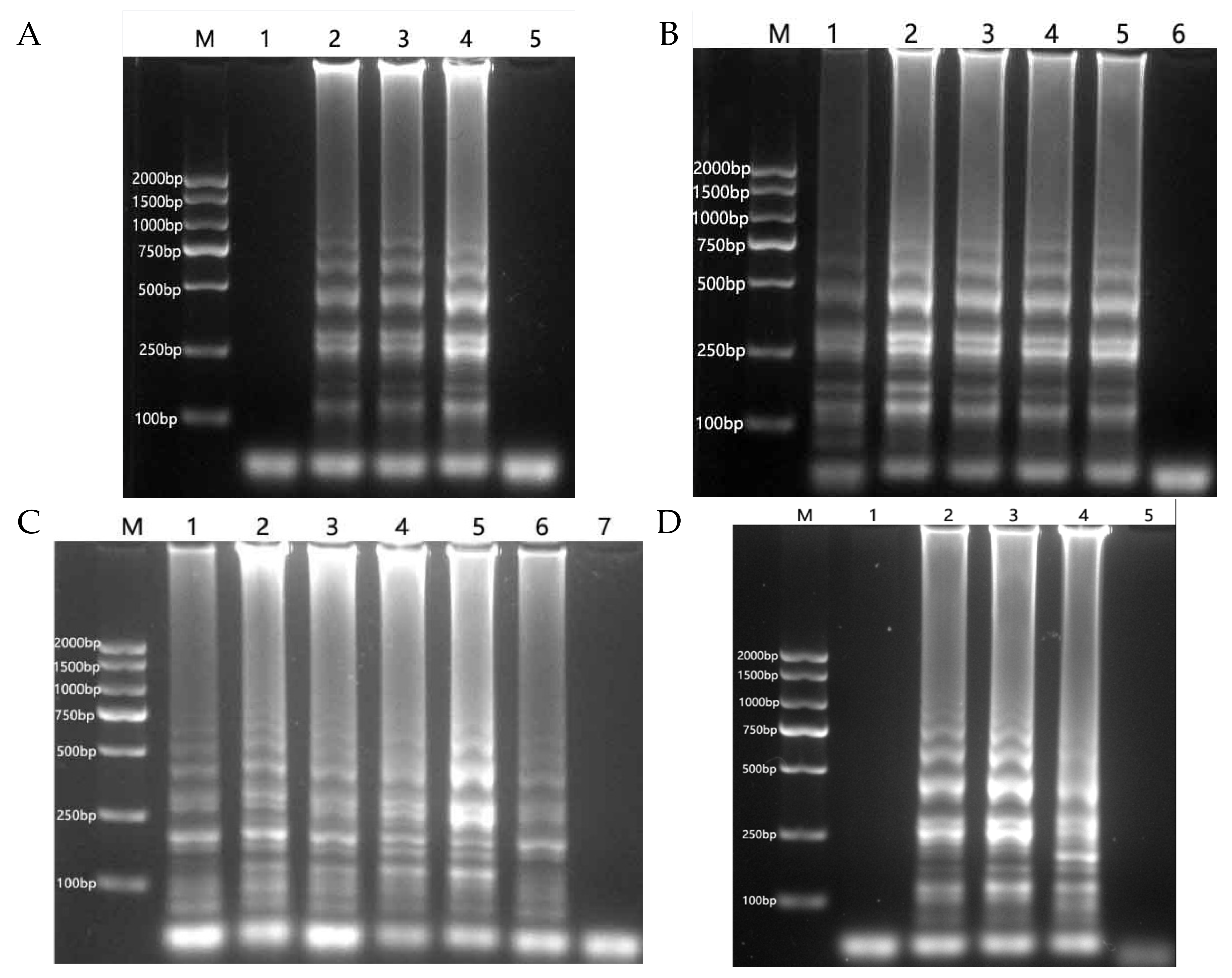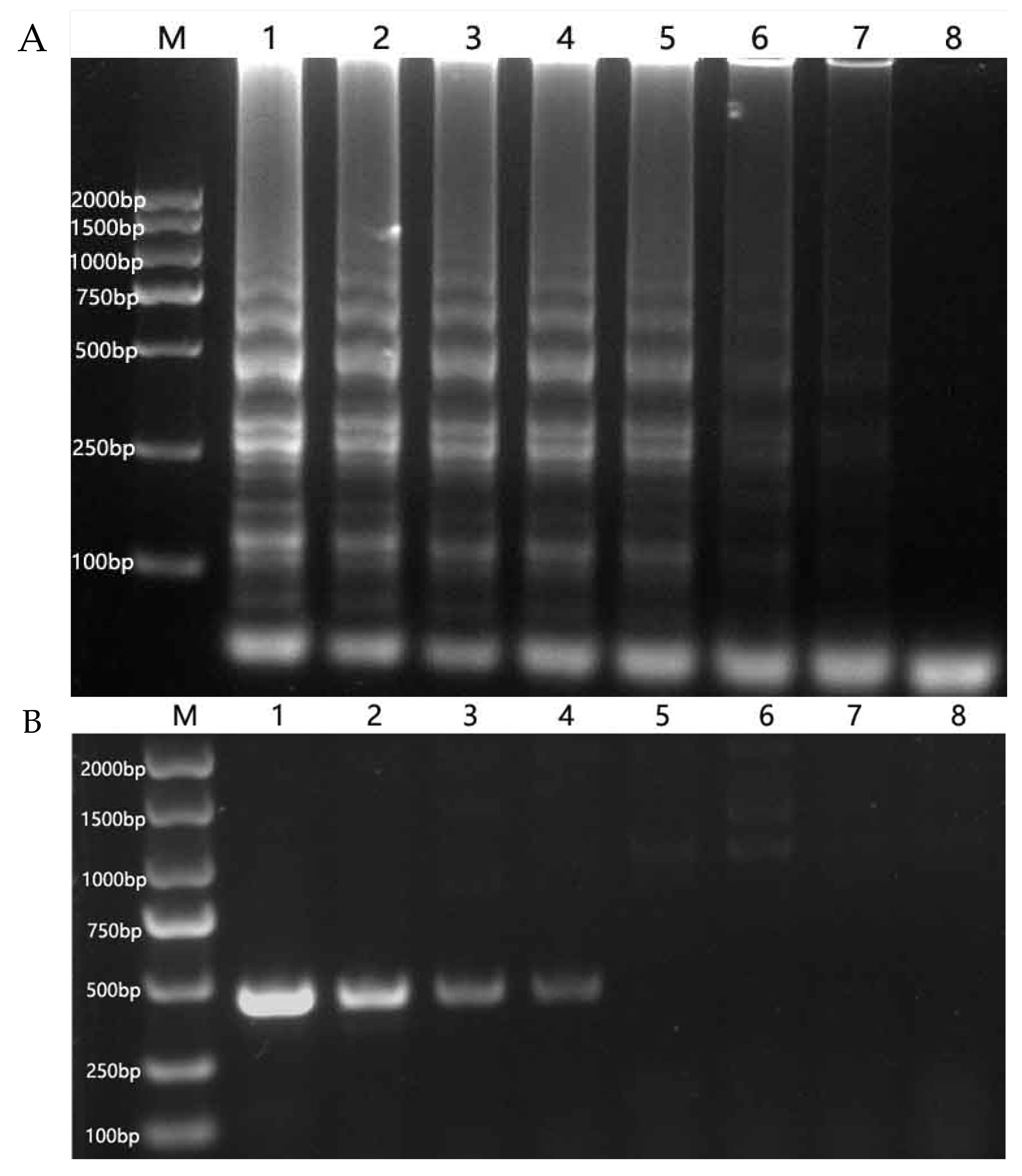Development of a Reverse-Transcription Loop-Mediated Isothermal Amplification Assay for Detecting Brassica Yellows Virus in China
Abstract
1. Introduction
2. Materials and Methods
2.1. Plant Material and Extraction of Total RNA
2.2. Primer Design
2.3. RT-LAMP
2.4. RT-PCR
2.5. RT-LAMP Sensitivity and Visualization Assay
3. Results
3.1. Oilseed Rape Plants with Leaf Yellowing and Curling Symptoms in Fields in Nanjinge
3.2. Optimization of RT-LAMP Reaction
3.3. RT-LAMP Sensitivity and Visualization Assay
4. Discussion
5. Conclusions
Author Contributions
Funding
Institutional Review Board Statement
Informed Consent Statement
Data Availability Statement
Conflicts of Interest
References
- Wang, Q.; Mao, J.; Xiang, Y.; Dong, H.; Sun, H.; Liu, S.; Liu, B. First Report of Brassica Yellows Virus on Tobacco in China. Plant Dis. 2015, 99, 1192. [Google Scholar] [CrossRef]
- Seungmo, L.; Hee, Y.; Davaajargal, I.; Fumei, Z.; Hyun, K.; Sun, M. Genome sequence of a recombinant brassica yellows virus infecting Chinese cabbage. Arch. Virol. 2015, 160, 597–600. [Google Scholar]
- Xiang, H.Y.; Dong, S.W.; Shang, Q.X.; Zhou, C.J.; Li, D.W.; Yu, J.L.; Han, C.G. Molecular characterization of two genotypes of a new polerovirus infecting brassicas in China. Arch. Virol. 2011, 156, 2251–2255. [Google Scholar] [CrossRef] [PubMed]
- Peng, Q.; Li, W.; Zhou, X.Y.; Sun, C.M.; Hou, Y.; Hu, M.L.; Fu, S.X.; Zhang, J.F.; Kundu, J.K.; Lei, L. Genetic Diversity Analysis of Brassica Yellows Virus Causing Aberrant Color Symptoms in Oilseed Rape. Plants 2023, 12, 1008. [Google Scholar] [CrossRef]
- Zhang, X.Y.; Xiang, H.Y.; Zhou, C.J.; Li, D.W.; Yu, J.L.; Han, C.G. Complete genome sequence analysis identifies a new genotype of brassica yellows virus that infects cabbage and radish in China. Arch. Virol. 2014, 159, 2177–2180. [Google Scholar] [CrossRef]
- Zhang, X.Y.; Dong, S.W.; Xiang, H.Y.; Chen, X.R.; Li, D.W.; Yu, J.L.; Han, C.G. Development of three full-length infectious cDNA clones of distinct brassica yellows virus genotypes for agrobacterium-mediated inoculation. Virus Res. 2015, 197, 13–16. [Google Scholar] [CrossRef]
- Zhang, X.Y.; Peng, Y.M.; Xiang, H.Y.; Wang, Y.L.; Yu, D.W.; Han, C.G. Incidence and prevalence levels of three aphid-transmitted viruses in crucifer crops in China. J. Integr. Agric. 2022, 21, 774–780. [Google Scholar] [CrossRef]
- Notomi, T.; Okayama, H.; Masubuchi, H.; Yonekawa, T.; Watanabe, K.; Amino, N.; Hase, T. Loop-mediated isothermal amplification of DNA. Nucleic Acids Res. 2000, 28, 63. [Google Scholar] [CrossRef]
- Fukuta, S.; Iida, T.; Mizukami, Y.; Ishida, A.; Ueda, J.; Kanbe, M.; Ishimoto, Y. Detection of Japanese yam mosaic virus by RT-LAMP. Arch. Virol. 2003, 148, 1713–1720. [Google Scholar] [CrossRef]
- Gross, A.J.; Lopez, S., Jr.; Rogers, A.; Adkins, S.; Breitbart, M. A reverse-transcription loop-mediated isothermal amplification (RT-LAMP) assay for the rapid colorimetric detection of pepper mild mottle virus (PMMoV). J. Virol. Methods 2025, 338, 115225. [Google Scholar] [CrossRef]
- Yan, A.; Lei, Y.T.; Yu, Z.Y.; Wu, G.L.; Feng, W.Z.; Chen, X.R. Establishment of one-step reverse-transcription loop-mediated isothermal amplification (RT-LAMP) assay for the detection of potato aucuba mosaic virus. Crop Prot. 2025, 197, 107317. [Google Scholar] [CrossRef]
- Qin, Y.H.; Wang, F.L.; Wen, Y.; Zhao, Z.W.; Gao, S.X.; Zhang, D.S.; Li, S.J.; Liu, Y.K.; Liu, Y.X.; Lu, S.H.; et al. Establishment of RT-LAMP method for rapid detection of youcai mosaic virus. Acta Phytopathol. Sin. 2024, 54, 829–834. [Google Scholar]
- Pavon, R.D.N.; Rivera, W.L. Loop-Mediated Isothermal Amplification Assay for Visual Detection of Salmonella enterica Serovar Typhimurium in Food Animal Meat Products. Foods 2025, 14, 1731. [Google Scholar] [CrossRef] [PubMed]
- Zhang, Y.M.; Yu, M.; Li, S.F.; Chen, Z.Y.; Chi, L.L.; Liu, J.; Yu, Z.H.; Zhang, M.Y.; Xu, S.Z. Establishment of a visual one step RT-LAMP for detection of bovine viral diarrhea virus. Chin. Vet. Sci. 2022, 52, 985–991. [Google Scholar]
- Wang, F.L.; Wang, F.; Lu, C.T.; Gao, S.X.; Liu, Y.X.; Wen, Y.; Yang, J.; Li, X.M.; Qi, W.P.; Liu, G.B.; et al. Establishment of RT-LAMP rapid detection method for yam latent virus. Acta Phytopathol. Sin. 2022, 1–6. [Google Scholar] [CrossRef]
- Yang, Z.X.; Li, Z.; Li, Z.R.; Li, L.; Yang, H.; Niu, B.S.; Yao, P.F.; Zhu, J.B. Establishment and application of a visual reverse transcriptase loop mediated iso-thermal amplification method for detection of Tibetorbivirus. Chin. J. Vet. Sci. 2022, 42, 892–896+912. [Google Scholar]
- Liu, S.R.; Tao, F.F.; Xiong, Y.X.; Wen, L.; Guo, Y.L.; Kong, L.B. Establishment of the RT-LAMP Visual Detection Method for Novel Coronavirus. Biol. Disaster Sci. 2022, 45, 415–422. [Google Scholar]
- Xu, C.; Huang, H.; Luo, H.J.; Du, J.N.; Huang, X.Y.; Chen, Y.; Liang, W.Q.; Hu, S. Establishment of RT-LAMP-HNB Method for Detection of Cymbidium mosaic Virus and Odontoglossum Ringspot Virus. Guangdong Agric. Sci. 2022, 49, 95–101. [Google Scholar]
- Zhang, X.Y.; Peng, Y.M.; Wang, Y.; Zhang, Z.Y.; Li, D.W.; Yu, J.L.; Han, C.G. Simultaneous detection and differentiation of three genotypes of Brassica yellows virus by multiplex reverse transcription-polymerase chain reaction. Virol. J. 2016, 13, 189. [Google Scholar] [CrossRef]
- Wang, J.Y.; Hou, X.L.; Yang, X.D. Identification of conserved microRNAs and their targets in Chinese cabbage (Brassica rapa subsp. pekinensis). Genome 2011, 54, 1029–1040. [Google Scholar] [CrossRef]
- Wang, C. Study and Application of ELISA Detection Technology for Shallot Latent Virus in Tiller Onion. Master’s Thesis, Jilin Agricultural University, Changchun, China, 2022. [Google Scholar]
- Deng, K.H.; Chen, Z.F.; Yu, T.; Wang, Z.L.; Wang, X.W.; Guo, Z.X.; Li, S.B.; Wei, K.; He, D.S. Detection of Three Porcine Diarrhea Coronaviruses PEDV, TGEV and PDCoV by RT-LAMP Based on N gene. Chin. J. Anim. Infect. Dis. 2025, 33, 70–79. [Google Scholar]
- He, Q.; Yu, K.; Guo, M.; Li, Y.J.; Lu, S.; Liu, J.; Li, J.H.; Wei, Z.D. Establishment of an EvaGreen qPCR for the detection of bovine adenovirus type 3 in bovine serum. Prog. Microbiol. Immunol. 2022, 50, 15–20. [Google Scholar]
- Ren, C.M.; Yang, L.; Miao, Q.; Lu, F.; Ji, Y.H.; Chen, Z.B. Establishment and application of IC-RT-PCR for cucumber green mottle mosaic virus in seeds and seed lings. Plant Prot. 2022, 48, 212–219. [Google Scholar]
- Sun, X.; Zhang, J.; Yang, L.; Lu, Q.Y. Establishment and Application of SYBR Green I Based qPCR Assay for the Detection of Mulberry Crinkle Leaf Virus. Acta Sericologica Sin. 2020, 46, 140–145. [Google Scholar]
- Cui, X.H.; Chen, S.S.; Yu, C.; Yang, C.Y. Detection of Carnation ringspot virus by real-time fluorescent reverse transcription polymerase chain reaction. Acta Phytopathol. Sin. 2012, 42, 381–386. [Google Scholar]
- Zhao, X.L.; He, C.Y.; Xu, T.F.; Li, X.F.; Liu, J.J.; Li, S.F.; Wang, H.Q. Construction of Infectious cDNA Clone of Brassica Yellows Virus Isolated from Strawberry and Establishment of TaqMan RT-qPCR. Plants 2022, 11, 3380. [Google Scholar] [CrossRef]
- Tang, X.Z.; Chen, L.W.; Lu, R.B.; Zheng, X.T.; Huang, C.Q. Dectection of Porcine Epidemic Diarrhea Virus by Calcein-based Visual Loop-mediated Isothermal Amplification (LAMP) Assay. China Anim. Husb. Vet. Med. 2015, 42, 331–336. [Google Scholar]
- Zhu, H.P.; Zheng, X.; Wang, H.; Gao, J.; Si, S.H.; Du, T.F.; Mu, Y. Establishment and application of visual LAMP method for Actinobacillus pleuropneumoniae detection. Chin. Vet. Sci. 2022, 52, 837–845. [Google Scholar]
- He, L.; Zhou, Y.Q.; Oosthuizen, M.C.; Zhao, J.L. Loop-mediated isothermal amplification (LAMP) detection of Babesia orientalis in water buffalo (Bubalus babalis, Linnaeus, 1758) in China. Vet. Parasitol. 2009, 165, 36–40. [Google Scholar] [CrossRef]
- Li, F.X.; Xia, J.X.; Yu, Y.F.; Zhu, P.; Yang, S.B.; Zhao, W.H.; Gao, H.F. Development of visual loop-mediated isothermal amplification assay for field detection of Corynebacterium pseudotuberculosis. Chin. Vet. Sci. 2023, 1–7. [Google Scholar] [CrossRef]
- Liu, N.N.; Yi, P.; Guo, A.Z.; Hu, C.M.; Chen, Y.Y. Establishment of visual LAMP method for detecting Mannheimia haemolytica in cattle. J. Huazhong Agric. Univ. 2023, 42, 32–37. [Google Scholar]
- Yin, X.Y.; Cao, J.J.; Li, X.; Piao, Y.Z. Rapid detection of cucumber green mottle mosaic virus based on visual RT-LAMP without nucleic acid extraction. Plant Prot. 2023, 49, 264–271. [Google Scholar]




| Assay | Primer Name | Genome Position | Sequence 5′-3′ | Tm |
|---|---|---|---|---|
| RT-LAMP | F3 | 1812–1828 | ACCTCCCCATGTGAGGTC | 62 °C |
| B3 | 2004–2021 | GTTCCAGCCACCGTGAAG | 64 °C | |
| FIP (F1c + F2) | 1849–1868 | CCGATGAGCGTCTTCCCCCA-CAAGCTGCCCCAATACTACC | / | |
| BIP (B1c + B2) | 1977–1998 | GATCCATCCCGCATTGGGTGAG-TCGCAGGCTCTTTAGTTCTG | / | |
| RT-PCR | F | 3572–3591 | CACAACGCCGACCTAGACGA | 68 °C |
| R | 3995–4015 | TCGATGAAGAACCATTGCCTT | 65 °C |
Disclaimer/Publisher’s Note: The statements, opinions and data contained in all publications are solely those of the individual author(s) and contributor(s) and not of MDPI and/or the editor(s). MDPI and/or the editor(s) disclaim responsibility for any injury to people or property resulting from any ideas, methods, instructions or products referred to in the content. |
© 2025 by the authors. Licensee MDPI, Basel, Switzerland. This article is an open access article distributed under the terms and conditions of the Creative Commons Attribution (CC BY) license (https://creativecommons.org/licenses/by/4.0/).
Share and Cite
Du, L.; Zhu, F.; Peng, Q.; Li, T.; Lin, F.; Zhou, X.; Kundu, J.K.; Hu, M.; Zhou, T. Development of a Reverse-Transcription Loop-Mediated Isothermal Amplification Assay for Detecting Brassica Yellows Virus in China. Agronomy 2025, 15, 2727. https://doi.org/10.3390/agronomy15122727
Du L, Zhu F, Peng Q, Li T, Lin F, Zhou X, Kundu JK, Hu M, Zhou T. Development of a Reverse-Transcription Loop-Mediated Isothermal Amplification Assay for Detecting Brassica Yellows Virus in China. Agronomy. 2025; 15(12):2727. https://doi.org/10.3390/agronomy15122727
Chicago/Turabian StyleDu, Linlin, Feng Zhu, Qi Peng, Tao Li, Feng Lin, Xiaoying Zhou, Jiban Kumar Kundu, Maolong Hu, and Tong Zhou. 2025. "Development of a Reverse-Transcription Loop-Mediated Isothermal Amplification Assay for Detecting Brassica Yellows Virus in China" Agronomy 15, no. 12: 2727. https://doi.org/10.3390/agronomy15122727
APA StyleDu, L., Zhu, F., Peng, Q., Li, T., Lin, F., Zhou, X., Kundu, J. K., Hu, M., & Zhou, T. (2025). Development of a Reverse-Transcription Loop-Mediated Isothermal Amplification Assay for Detecting Brassica Yellows Virus in China. Agronomy, 15(12), 2727. https://doi.org/10.3390/agronomy15122727







